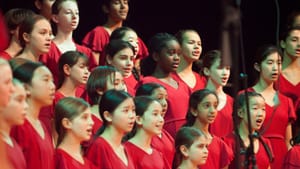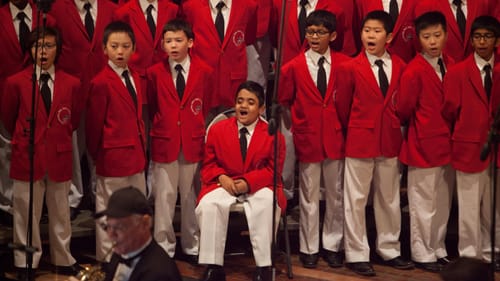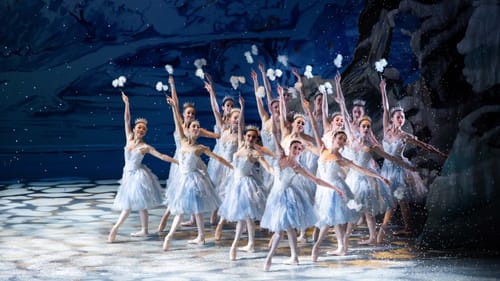Stay in the Loop
BSR publishes on a weekly schedule, with an email newsletter every Wednesday and Thursday morning. There’s no paywall, and subscribing is always free.
The voices behind the Philadelphia Ballet’s “Waltz of the Snowflakes”
Meet the young Philly singers who help make The Nutcracker magical

In an era where technology is increasingly standing in for human performers, the Philadelphia Ballet’s Nutcracker has a secret weapon: two choirs of real Philly youngsters sing the snowflakes.
December is the busiest month of the year for the Philadelphia Boys Choir and Chorale and Girls Choir, with concerts from Hammonton to Wayne, including two at the Church of the Holy Trinity on Rittenhouse Square. But the big event plays out over 30 performances of the Philadelphia Ballet’s Nutcracker at the Academy of Music. For three minutes every evening and matinee, they steal the show.
"The Waltz of the Snowflakes" at the end of Act 1, is one of the most enchanting dances in ballet. After the more realistic family party, it transitions the story fully into the fantastical. Delicate yet complex contrapuntal music evokes the fall of snow, while the dancers dart across the stage like snowflakes tossed in the wind. Then, rising like a swirl of snow from both sides of the stage, the voices of the children’s choirs join the music with wordless melody. Audiences dart glances from side to side, nudge their neighbors, and point at the singers in the proscenium boxes. It is such a small part of the two-hour runtime—the waltz is about six minutes long with the vocals entering for just three minutes—yet it’s one of the most memorable parts of the ballet.
Meet the young singers
I had to know more about the Philadelphia Boys and Girls Choirs that create those aethereal sounds, so I checked in with Jeffrey R. Smith, artistic director and conductor of the Philadelphia Boys Choir and Chorale, and Nathan Wadley, who holds the same positions for the Philadelphia Girls Choir.
The Philadelphia Boys Choir and Chorale was founded in the 1960s and was part of the school district until the 1980s. Newscaster Ukee Washington was a choir member in the 1960s and often talks about singing in The Nutcracker, and Smith remembers his own time in the choir in the 1980s. “I was 8,” he said. “[I] didn’t want to audition. I was crying in the car, but my parents said, ‘Well, just give it a shot.’ [Director] Doctor Hamilton said, ‘You’re in!’ and I was ecstatic.” He remembers touring countries like Russia and Germany before the wall came down: “Sometimes, these were places where they hadn’t really seen Americans. So we felt a responsibility to represent ourselves, our group, and our country, well.”

The Girls Choir has participated in The Nutcracker since 2014, just a year or so after it was founded. When I asked Wadley why it took so long for the girls, he said, “The boy choir tradition is over a thousand years old. It began in Western churches.” He ties the growth of girls’ choirs to social movements creating equal spaces for girls. For The Nutcracker, Tchaikovsky only specified a children’s choir and said that if one were not available, women’s voices would serve as well, so even the composer would approve.
Backstage at The Nutcracker
It’s a huge undertaking. Each performance has 40 singers; Wadley breaks the girls’ choir into three groups and Smith breaks the smaller boys’ choir into three parts of 20, rotating so that two-thirds of the choir is at any one performance. If the girls have a concert, the boys sing, and vice versa.
As the curtain rises on the stage, choir members start to gather at an upstairs rehearsal hall for a final warm-up and run-through. According to Smith, the singers are split into two groups, and parent volunteers check to make sure everyone looks sharp in their uniforms. Then, 40 minutes into the performance, they walk down, through the backstage area, past the offices, where they wait for their cue: a cymbal crashes, the lighting changes, and they walk unseen across the stage behind the scrim.
It comes right after the Christmas tree has grown to its full height. The mice are getting ready to go onstage, and a few of the snowflakes are warming up. Wadley said, “The first time the kids experience it is great. They have no idea that they are about to actually walk on the stage while the dancers are dancing, [with] the lights and the audience, and we cross right at an applause point.” Smith added, “That is when the realization hits that it’s not just a concert, it’s a theatrical production.” When I said that must be exciting, Smith said, “Oh, yes,” with a gleam in his eye, remembering his own days crossing the same stage.

It's still not time to take their places, however. They cross when the area is clear of moving parts and then wait for their next cue, after the battle with the mouse king. One group heads up to the first proscenium box, and the other group treks through the hall around the auditorium to reach the second box. It’s controlled chaos, but somehow, there they are: with snow falling and snowflakes dancing, they raise their voices like the skirl of a winter wind for three minutes. The audience goes wild, the curtain comes down, and they are done. Most will grab their coats and go home, but some families make an event of it, with tickets so the chorister can watch the second half, and maybe hit City Hall’s Christmas Village for hot chocolate afterward.
“You don’t see anything that happens before you,” Smith said. “And then you’re not at all part of the second half. And that’s a big part of performing: knowing what piece you play in the overall story. It’s the last thing [the audience] sees before intermission, so it’s important that they are disciplined and professional and not watching the dancers, and maintaining that composure. Because for the audience, it’s all one big picture.”
Real voices make a difference
The Nutcracker is unique in the number of children who participate in a major professional theatrical production. George Balanchine has given the young dancers real choreography to perform, and the choir adds an ineffable quality that promises magic to come in Act 2. But according to Smith and Wadley, those soaring voices are increasingly being replaced by synthesizers. It’s a lot of performances and requires a lot of voices. Fortunately for Philadelphians, Smith told me, “I know the [Philadelphia] Ballet is very proud that they use a live choir and not a synth.” The choirs add a lot to the performance: their otherworldly vocal interlude, but also, the frisson that passes through the audience, the moment of delight when they spot the singers and their view widens.
It’s also important for singers. “I’ve been doing it since I was a kid. I never get tired of it. The music is just so beautiful, and the excitement of the production,” Smith remembered. Many dancers point to The Nutcracker as the reason they started ballet lessons. And if budding singers, entranced by the music, yearn for a place in the proscenium box, they can audition for the choir.
What, When, Where
The Nutcracker. Choreography by George Balanchine; music by Pyotr Ilyich Tchaikovsky. Philadelphia Ballet. $25-$258 (plus fees from $4-$30). December 6-29, 2024, at the Academy of Music, 240 S Broad Street, Philadelphia. (215) 893-1999 or philadelphiaballet.org.
Accessibility
The Academy of Music is a wheelchair-accessible venue. The performance on Thursday, December 26, at 12pm is a sensory-friendly event.
Sign up for our newsletter
All of the week's new articles, all in one place. Sign up for the free weekly BSR newsletters, and don't miss a conversation.

 Camille Bacon-Smith
Camille Bacon-Smith